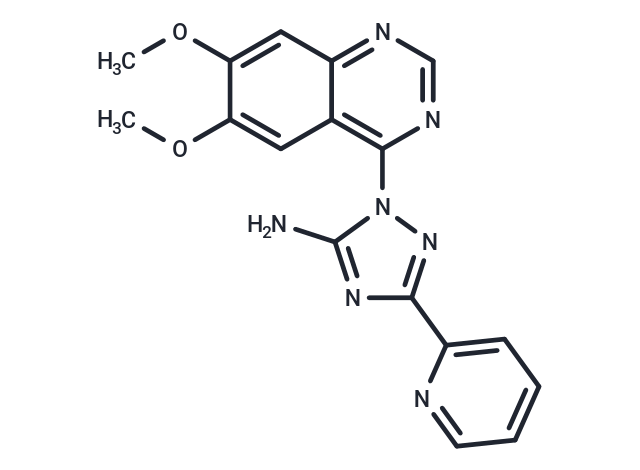Shopping Cart
- Remove All
 Your shopping cart is currently empty
Your shopping cart is currently empty

CP-466722, an effective and reversible ATM inhibitor, does not inhibit ATR and PI3K or PIKK family members in cells.

| Pack Size | Price | Availability | Quantity |
|---|---|---|---|
| 1 mg | $30 | In Stock | |
| 2 mg | $44 | In Stock | |
| 5 mg | $68 | In Stock | |
| 10 mg | $117 | In Stock | |
| 25 mg | $193 | In Stock | |
| 50 mg | $312 | In Stock | |
| 100 mg | $506 | In Stock | |
| 500 mg | $1,130 | In Stock |
| Description | CP-466722, an effective and reversible ATM inhibitor, does not inhibit ATR and PI3K or PIKK family members in cells. |
| Targets&IC50 | ATM:410 nM |
| In vitro | CP-466722 is used as a potential inhibitor to inhibits the activity of ATM kinase, which phosphorylates GST-p53(1–101) substrate. CP-466722 also exhibits the decreasing activities against abl and src kinases. In MCF-7 human breast cancer cells and primary and immortalized diploid human fibroblasts, CP-466722 suppress ATM-dependent p53 induction. In HeLa cells, CP-466722(6 μM), leads to the inhibition in ATM-dependent phosphorylation by reversibly inhibiting ionizing radiation (IR)-induced ATM kinase activity. |
| Kinase Assay | In vitro kinase assays [1] : To screen for small molecule inhibitors of ATM kinase activity, an in vitro kinase assay is adapted, and an ELISA assay develops which measured the phosphorylation status of the ATM downstream target p53. Recombinant GST-p53(1-101) and full-length Flag-tagged ATM & ATR are purified for use in the ELISA and in vitro kinase assays. Briefly, Nunc 96 well Maxisorp plates are coated overnight (4 °C) with 2μg of purified, recombinant GST-p53(1-101) in PBS. All subsequent incubations are performed at room temperature. The plates are washed (0.05%v/v-Tween/PBS) before addition of purified recombinant full-length ATM kinase (30 ng–60 ng) in a final volume of 80μL of reaction buffer (20 mM HEPES, 50 mM NaCl, 10 mM MgCl2, 10 mM MnCl2, 1 mM DTT and 1 μM ATP) in the presence or absence of CP-466722. CP-466722 (10 μM) is added to plates in duplicate and the kinase assay is incubated (90 minutes). Plates are washed (0.05%v/v-Tween/PBS), blocked (1hour, 1%w/v-BSA/PBS) and rinsed before anti-Phospho(Ser15)-p53 antibody (1:1000/PBS) is added to the plates and incubated (1hour). To reduce non-specific binding plates are washed (0.05%v/v-Tween/PBS) prior to incubation (1hour) with HRP-conjugated goat anti-rabbit IgG secondary antibody (1:5000/PBS). Secondary antibody that is linked to the phosphorylated GST-p53(1–101) protein is detected with TMB substrate reagent. Plates are developed (15 minutes–30 minutes) and the reaction is stopped (1 M H2SO4 final concentration) before absorbance is determined (λ450 nM). CP-466722 that inhibits ATM kinase activity in ELISA assays, are characterized with respect to inhibition of ATM/ATR kinases using in vitro kinase assays. Western blotting using the anti-Phospho(Ser15)-p53 antibody is used as a readout of ATM/ATR inhibition. Extended analysis of CP466722 (10 μM) against a commercially available panel of kinases is performed by Upstate. |
| Cell Research | HeLa or A-T (GM02052 expressing hTERT) cells are plated in triplicate and incubated for 24 hours. Cells are pre-treated: DMSO, CP466722 or KU55933 prior to IR (0-10 gy). Cells are incubated for 4 hours following IR before media is removed, cells washed (PBS), trypsined, counted and re-plated (2000 cells/plate, 10 cm plates) in the absence of drug and incubated for 10 days. Prior to colony counting, cells are washed (PBS), stained (PBS, 0.0037%v/v-formaldehyde, 0.1%w/v-crystal violet), rinsed (dWater) and dried. Defined populations (>50 cells) are counted as one surviving colony, data are calculated as percentage surviving colonies relative to control plates +/− SE. (Only for Reference) |
| Alias | CP466722, CP 466722 |
| Molecular Weight | 349.35 |
| Formula | C17H15N7O2 |
| Cas No. | 1080622-86-1 |
| Smiles | COc1cc2ncnc(-n3nc(nc3N)-c3ccccn3)c2cc1OC |
| Relative Density. | 1.48 g/cm3 |
| Storage | Powder: -20°C for 3 years | In solvent: -80°C for 1 year | Shipping with blue ice. |
| Solubility Information | DMSO: <1 mg/mL (insoluble or slightly soluble), Sonication is recommended. |

Copyright © 2015-2025 TargetMol Chemicals Inc. All Rights Reserved.